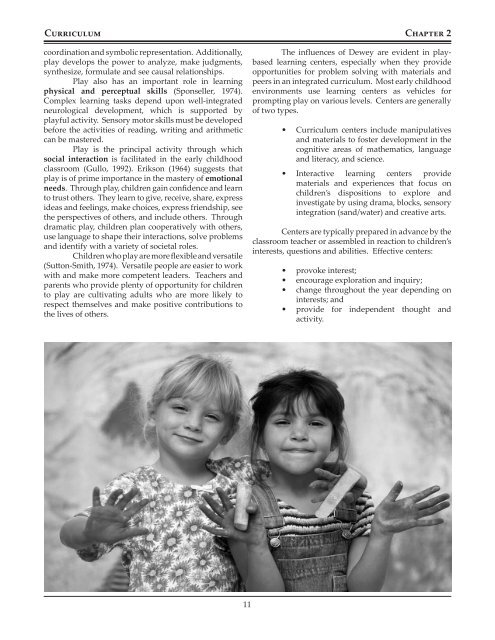Early Childhood
Early Childhood
Early Childhood
Create successful ePaper yourself
Turn your PDF publications into a flip-book with our unique Google optimized e-Paper software.
Curriculum Chapter 2<br />
coordination and symbolic representation. Additionally,<br />
play develops the power to analyze, make judgments,<br />
synthesize, formulate and see causal relationships.<br />
Play also has an important role in learning<br />
physical and perceptual skills (Sponseller, 1974).<br />
Complex learning tasks depend upon well-integrated<br />
neurological development, which is supported by<br />
playful activity. Sensory motor skills must be developed<br />
before the activities of reading, writing and arithmetic<br />
can be mastered.<br />
Play is the principal activity through which<br />
social interaction is facilitated in the early childhood<br />
classroom (Gullo, 1992). Erikson (1964) suggests that<br />
play is of prime importance in the mastery of emotional<br />
needs. Through play, children gain confidence and learn<br />
to trust others. They learn to give, receive, share, express<br />
ideas and feelings, make choices, express friendship, see<br />
the perspectives of others, and include others. Through<br />
dramatic play, children plan cooperatively with others,<br />
use language to shape their interactions, solve problems<br />
and identify with a variety of societal roles.<br />
Childrenwhoplayaremoreflexibleandversatile<br />
(Sutton-Smith, 1974). Versatile people are easier to work<br />
with and make more competent leaders. Teachers and<br />
parents who provide plenty of opportunity for children<br />
to play are cultivating adults who are more likely to<br />
respect themselves and make positive contributions to<br />
the lives of others.<br />
11<br />
The influences of Dewey are evident in playbased<br />
learning centers, especially when they provide<br />
opportunities for problem solving with materials and<br />
peers in an integrated curriculum. Most early childhood<br />
environments use learning centers as vehicles for<br />
prompting play on various levels. Centers are generally<br />
of two types.<br />
• Curriculum centers include manipulatives<br />
and materials to foster development in the<br />
cognitive areas of mathematics, language<br />
and literacy, and science.<br />
• Interactive learning centers provide<br />
materials and experiences that focus on<br />
children’s dispositions to explore and<br />
investigate by using drama, blocks, sensory<br />
integration (sand/water) and creative arts.<br />
Centers are typically prepared in advance by the<br />
classroom teacher or assembled in reaction to children’s<br />
interests, questions and abilities. Effective centers:<br />
• provoke interest;<br />
• encourage exploration and inquiry;<br />
• change throughout the year depending on<br />
interests; and<br />
• provide for independent thought and<br />
activity.


